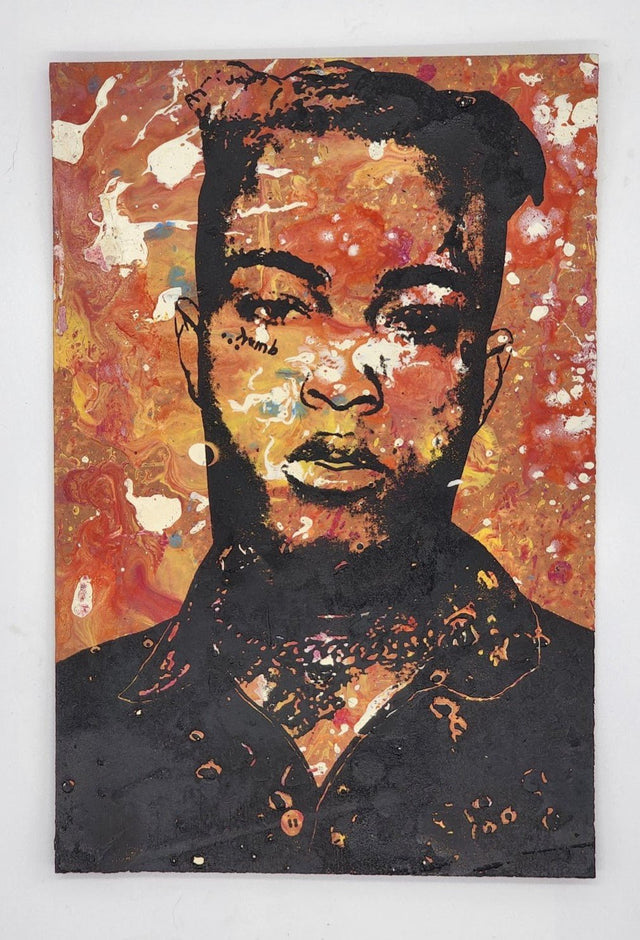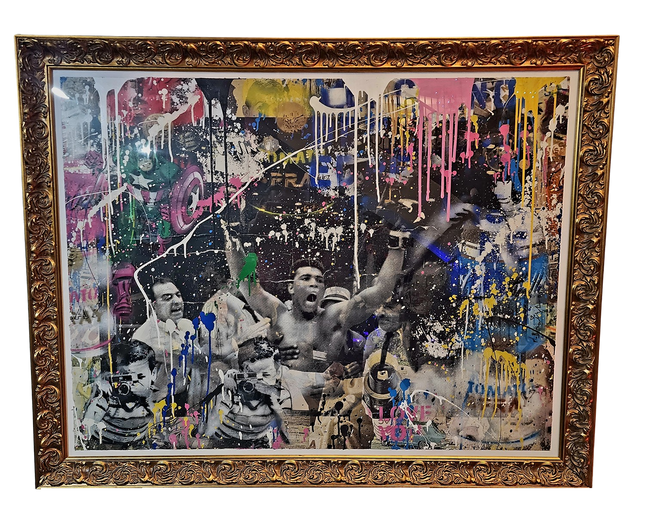
Man Male

Mr Brainwash- Thierry Guetta Absolute Ali Unique Original Spray Paint Silkscreen by Mr Brainwash- Thierry Guetta
Absolute Ali Unique Original HPM Spray Paint Silkscreen Print by Mr. Brainwash- Thierry Guetta Mixed Media Screen Print on Deckled Fine Art Paper Limited Edition Pop Street Art Artwork. 2017 Signed Custom Framed with COA Spray Paint, Acrylic Paint Mixed Media Unique HPM Embellished Original Artwork Size 48.5x35.5. Famous Boxer Muhammad Ali Raising Hands in Boxing Sports Victory with Tons of Colorful Spray Paint & Paint Hand-Embellished. Custom Ornate Gold Frame Size 57x45 Evolution and Impact of Mr. Brainwash's Street Pop and Graffiti Artwork The vibrant and irreverent energy of Street Pop Art and Graffiti Artwork has radically transformed the visual landscape of urban culture. These forms of artistic expression, which have their roots deeply embedded in the subversive countercultures of the past, have now ascended to the pantheon of high art, thanks to the works of visionaries like Thierry Guetta, also known as Mr. Brainwash. His unique approach to art, which combines elements of both street art and pop art, has resulted in creations that are not only visually stunning but also rich in cultural commentary. Mr. Brainwash burst onto the art scene with his innovative blend of street art sensibilities and pop art aesthetics. His work often incorporates iconic figures and familiar motifs, recontextualizing them within street art's urban grit and spontaneous energy. His 2017 "Absolute Ali" piece is a powerful testament to this style. By using silkscreen printing and hand embellishments with spray and acrylic paints, Mr. Brainwash creates a multi-layered texture that echoes the complexity of the cultural icon it depicts: the legendary boxer Muhammad Ali. "Absolute Ali" - A Masterpiece of Mixed Media "Absolute Ali" stands as a stunning example of Mr. Brainwash's artistry. This piece showcases a limited edition, mixed media screen print on fine art paper featuring the heavyweight champion Muhammad Ali. The artwork captures the triumphant moment of Ali raising his hands in victory, immortalizing the emotion and power of the sports legend. Through the application of vibrant and chaotic splashes of color, the artwork is infused with a sense of movement and dynamism characteristic of both Ali's boxing style and Mr. Brainwash's artistic approach. This work is not just a mere portrait but a celebration of triumph, diversity, and the indomitable spirit of the human will, as embodied by Ali. The backdrop of the composition is a veritable collage of imagery and color, with each layer of paint and each silkscreened element building upon the last to create a rich tapestry of visual stimuli. The piece is a feast for the senses, with the hand-embellished splatters of paint not only adding texture but also creating an almost palpable energy that radiates from the canvas. The Role of Street Pop and Graffiti Artwork in Contemporary Art Artworks like "Absolute Ali" are pivotal examples of how Street Pop Art and Graffiti Artwork have shifted the boundaries of traditional art. They reflect the cultural zeitgeist, encapsulating the streets' voices, struggles, and victories. By bringing such work into galleries and the realm of fine art, artists like Mr. Brainwash challenge preconceived notions of what art can be and who it is for. This democratization of art has led to a more inclusive and diverse art world where the line between high art and street culture is increasingly blurred. The limited edition nature of "Absolute Ali," coupled with its hand-embellished features, ensures that each piece is a unique treasure, representing Mr. Brainwash's vision. The artwork's custom ornate gold frame further enhances its allure, juxtaposing the traditionally luxurious connotations of gold and the raw, unrefined essence of street art. For collectors, owning a piece like "Absolute Ali" is not just an investment in art; it is an investment in cultural history, a snapshot of when street art rose to prominence and reshaped the art world. "Absolute Ali" is more than just a work of art. It is a cultural artifact that embodies the essence of Street Pop and Graffiti Artwork. Through the fusion of silkscreen printing and spray paint, Mr. Brainwash has created an artwork that vibrates with life, encapsulating the spirit of Muhammad Ali and the essence of street art. It is a bold statement in the ongoing narrative of art history, highlighting the ever-evolving nature of artistic expression and the power of art to capture the human experience.
$45,000.00


